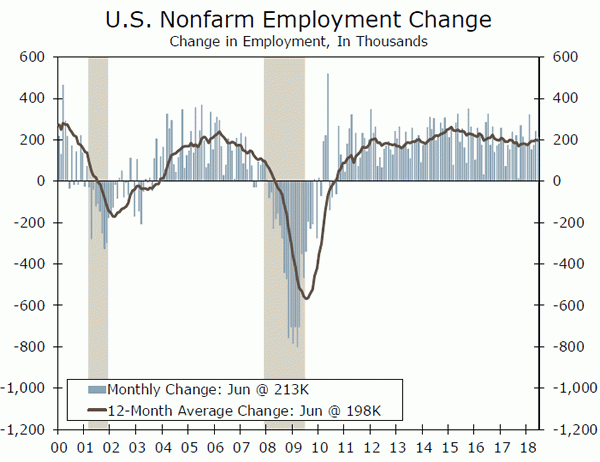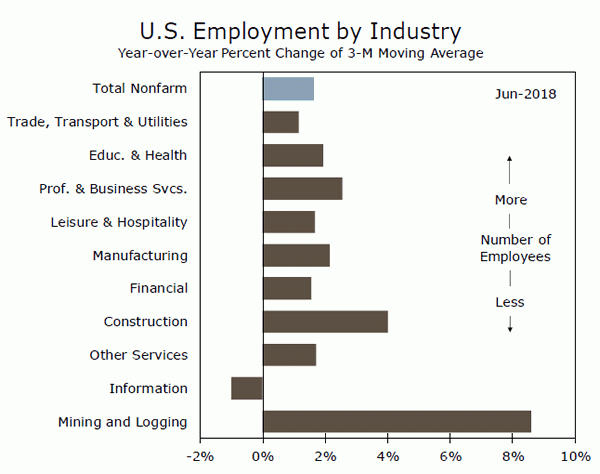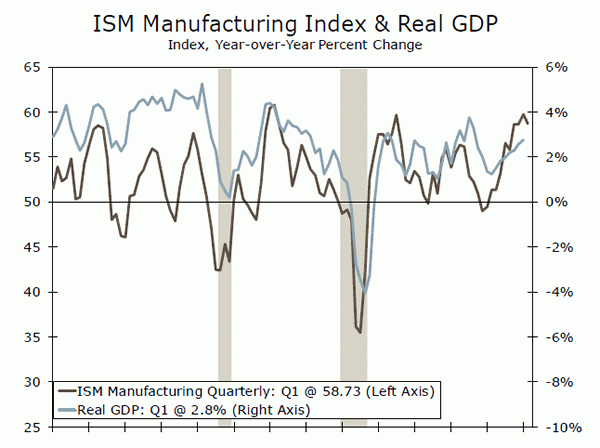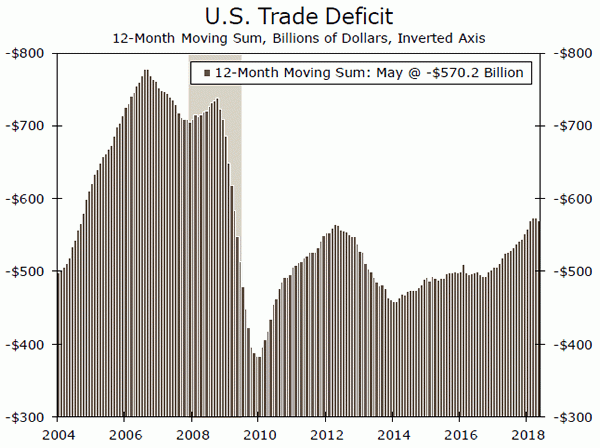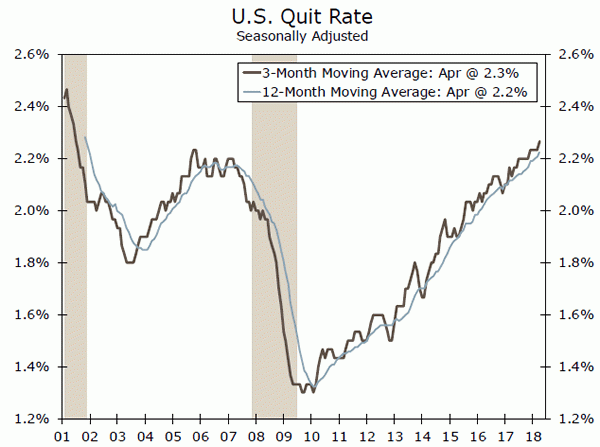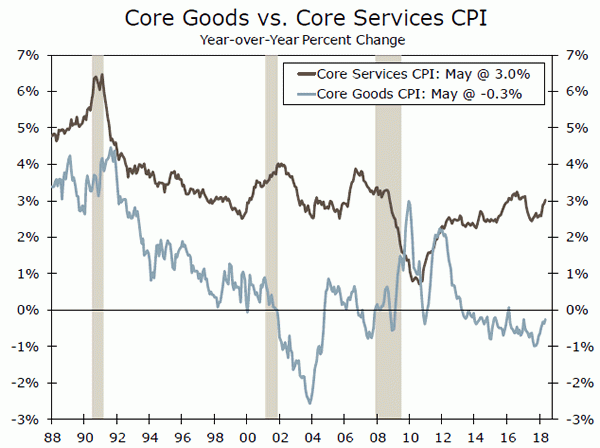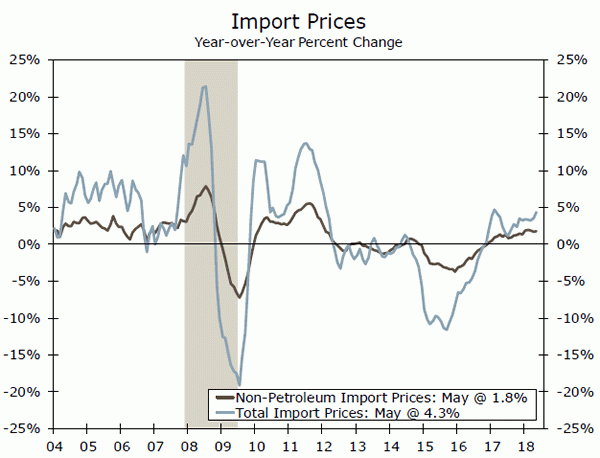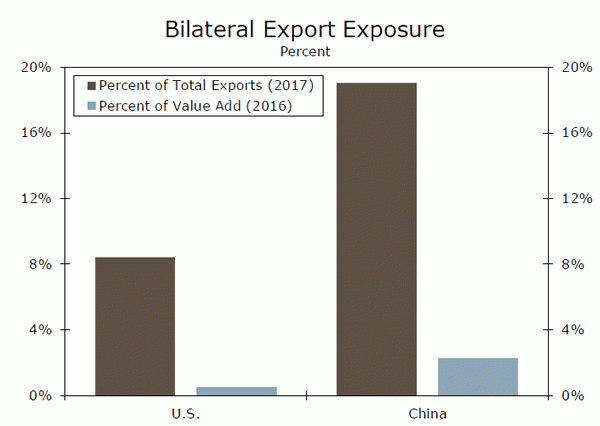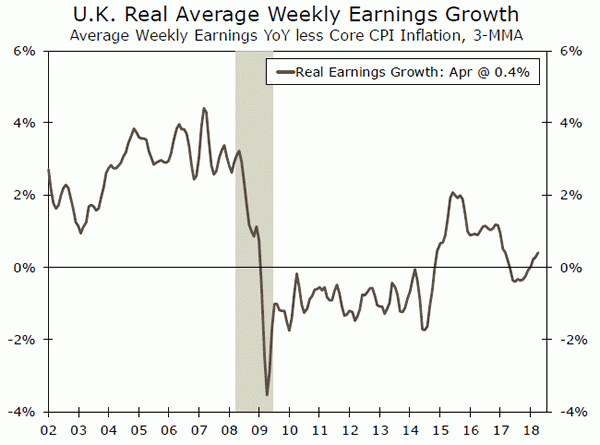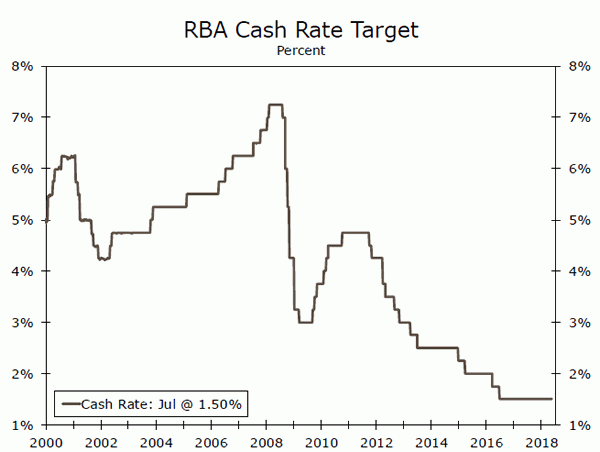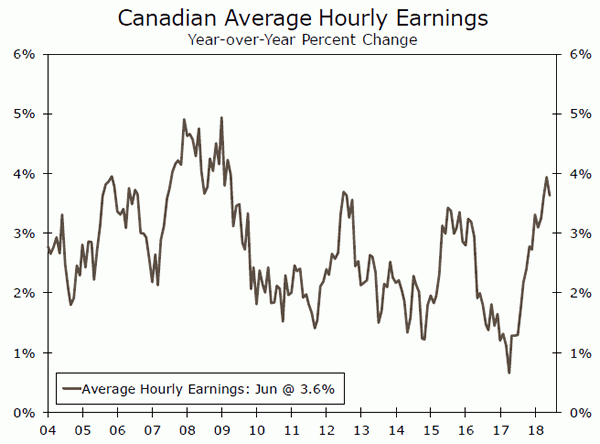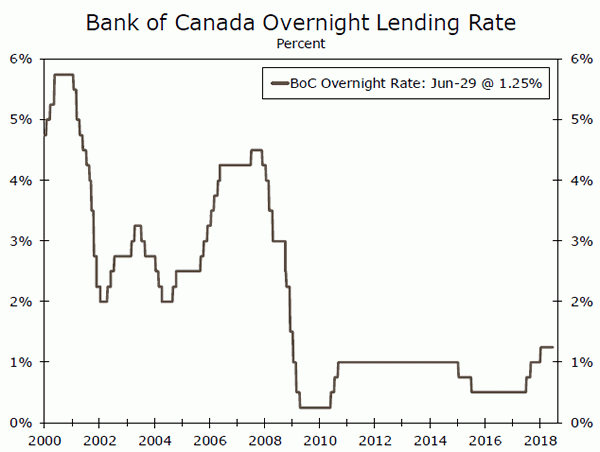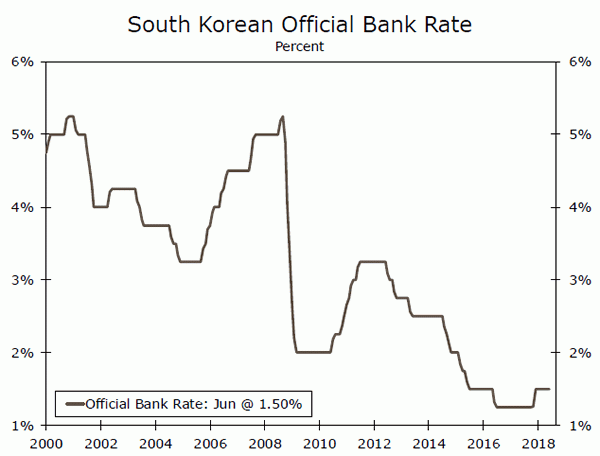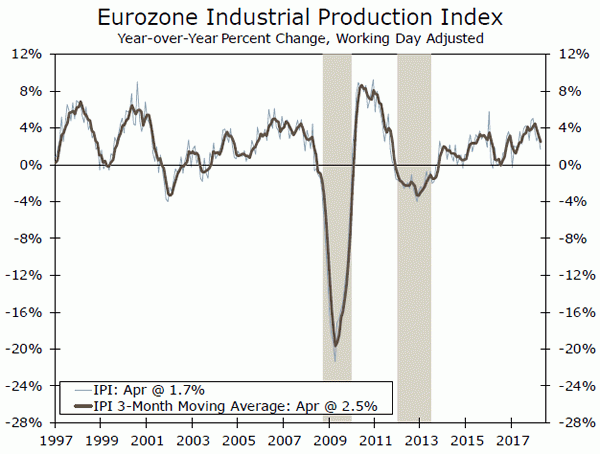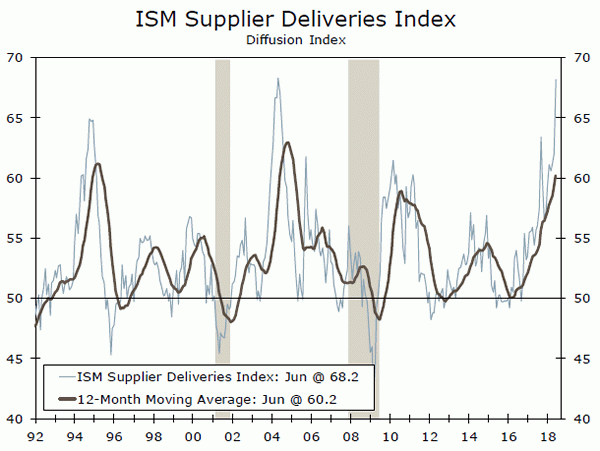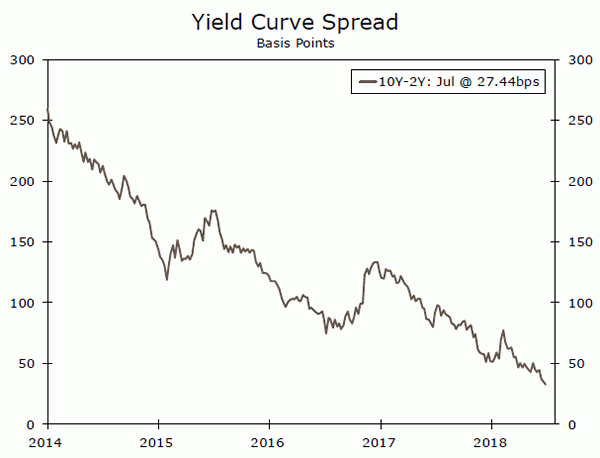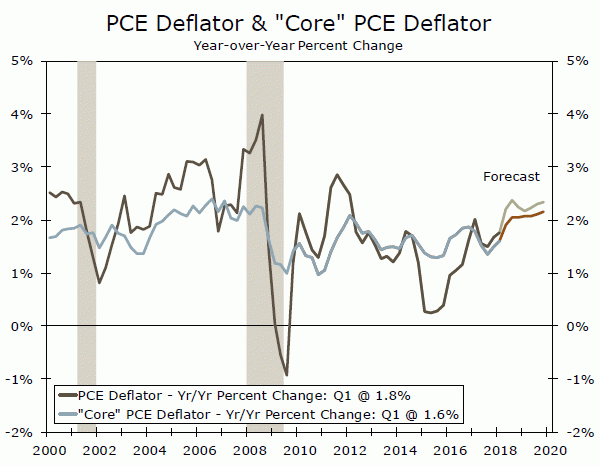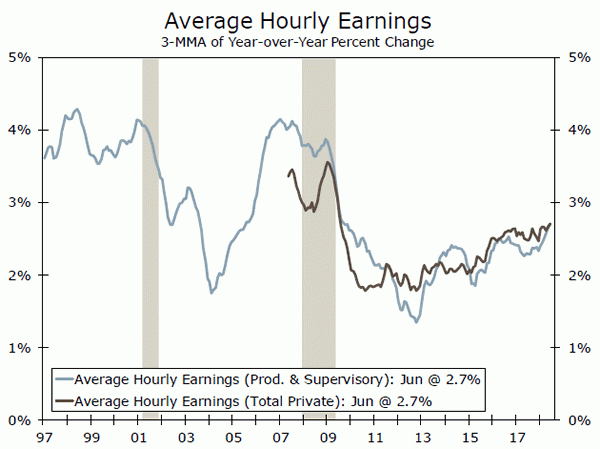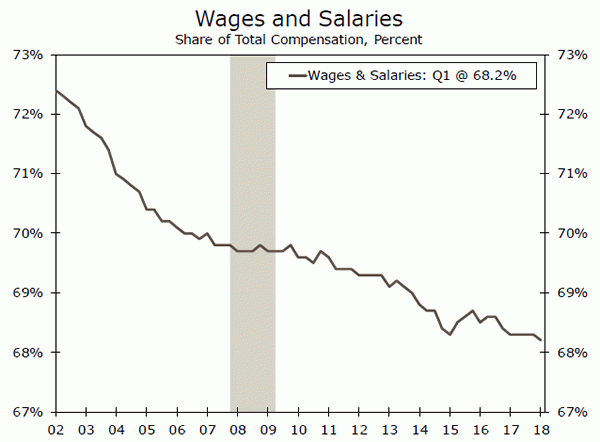U.S. Review
All Signs Point to Stronger Second Quarter GDP Growth
- Employers added 213,000 new jobs in June. The unemployment rate ticked up to 4.0 percent on an increase in labor force participation. Average hourly earnings grew 0.2 percent in June and are up 2.7 percent year-over-year.
- Manufacturing activity remained strong in June, as the ISM manufacturing index increased to 60.2. The production and employment indices were solid, while new orders remained elevated. Prices paid continue to rise at a solid clip.
- The trade balance narrowed to $43.1 billion in May as exports jumped 1.9 percent ahead of new tariffs. Imports also rose 0.4 percent.
All Signs Point to Stronger Second Quarter GDP Growth
The labor market remained hot in June. Employers added 213,000 new jobs, while May’s gain was revised up to 244,000 from 223,000. Gains in June were broad based, with most industries adding jobs over the month. The unemployment rate ticked up to 4.0 percent; however, the upward movement was due to a 0.2 percentage point increase in the labor force participation rate. Meanwhile, average hourly earnings increased 0.2 percent for the month and 2.7 percent on a year-over-year basis.
Activity in the factory sector remained strong in June as the ISM manufacturing index increased to 60.2. The production and employment indices displayed solid gains, further evidence that Q2 GDP is on track for above 4 percent growth. There was also little evidence of tariffs having an effect on the manufacturing sector in June. The new orders index fell slightly for the month; however, it remains elevated, with 16 of the 18 indices reporting growth in new orders. Manufacturing firms, however, continued to report supply chain bottlenecks that may be limiting production and putting upward pressure on prices. The prices paid measure also came in at 76.8 in June, in-line with the six-month average and a signal that input costs continue to rise.
Factory orders also increased 0.4 in May. Nondurable goods orders accounted for much of the gain and jumped 1.1 percent. Core capital goods orders were also revised up to a 0.3 percent gain from an initially-reported decline. While factory orders in May were stronger than expected, equipment spending has fallen below the double-digit pace registered in the second half of 2017. Despite the downshift, equipment investment should remain additive to second quarter GDP growth.
Activity outside of the manufacturing sector also picked up in June, as the ISM non-manufacturing index expanded to 59.1. New orders increased, while current business activity also strengthened. Supplier delivery times and backlogs moderated somewhat in June, but capacity constraints appear to remain in place. The prices paid index also came in above 60 for the sixth consecutive month. While the employment index fell to 53.6, June’s rise in the overall index is consistent with a solid second quarter rebound in real GDP growth.
Construction spending increased 0.4 percent in May, falling slightly short of expectations. However, spending remains on solid footing and is up 4.3 percent year-to-date through May. The monthly gain was due to a 0.8 percent increase in residential expenditures, as multifamily, single-family and improvement spending all increased in May. Meanwhile, nonresidential outlays grew 0.1 percent, with public sector spending rising 0.7 percent and private spending falling 0.3 percent.
The trade balance narrowed to $43.1 billion in May. Exports looked to have jumped in anticipation of new tariffs and increased 1.9 percent. Imports also grew 0.4 percent for the month. With the trade gap falling for the third consecutive month, we expect trade to be a substantial boost to the second quarter GDP.
U.S. Outlook
JOLTS • Tuesday
The number of job openings rose above the number of unemployed workers in April for the first time, in a sign of an ever-tightening labor market. Job openings increased to 6.70 million, a record high since the series began in December 2000. There appears little reprieve in sight for employers facing difficulty hiring workers.
Quits stayed constant in April as a share of total employment. The volume of quits indicates confidence in the job market on the part of workers and signals upward pressure on average wages; job switching tends to reflect individuals moving up the job ladder to higher-paying positions. After being stuck between 2.1 percent and 2.2 percent for most of 2016 and 2017, the quit rate has jumped up to 2.3 percent. We will be watching the quit rate in the May release for further indication that employers are increasingly poaching employees from other firms and as an early signal of faster wage growth.
Previous: 6.70 Million Consensus: 6.66 Million
Consumer Price Index • Wednesday
The consumer price index (CPI) rose 0.2 percent in May and is up 2.8 percent year-over-year, boosted in part by higher gasoline prices. Higher core services prices mean that the core index (ex-food and energy) is also exhibiting strength, up 0.2 percent in the month and 2.2 percent over the year. On a 12-month basis, the headline and core are growing at the fastest rate in at least a year.
Divergence between core services and core goods price growth has continued even as inflation broadly picks up. Core services prices rose 0.3 percent in May while core goods declined 0.1 percent for a third consecutive month. This means that all the growth in core CPI is due to the services side, which was supported in April by another solid increase in shelter costs. Core goods prices were weighed down by drops in household furnishings and used auto prices. We expect headline and core CPI to be up another 0.2 percent in June.
Previous: 0.2% Wells Fargo: 0.2% Consensus: 0.2% (Month-over-Month)
Import Prices • Friday
Import prices rose 0.6 percent in May, in large part due to higher fuel prices. Excluding fuels, prices rose a more muted 0.2 percent. So far this year, a stronger dollar and softening in global growth have dampened import price inflation, which was running as high as 0.5 percent ex-fuels in January. The strongest growth in May by enduse category came from industrial supplies prices, while prices for capital goods and automotive parts declined. We expect import prices to have advanced 0.2 percent in June, bringing year-over-year growth up to 4.8 percent.
Tariffs are not included in the import price index, since they are added on later. However, recent flattening in the underlying pace of import price growth should help ease the final cost burden to purchasers of imports when tariffs are applied. Steel and aluminum tariffs were extended to the European Union, Mexico and Canada on June 1 and tariffs on $34 billion of Chinese goods took effect July 6.
Previous: 0.6% Wells Fargo: 0.2% Consensus: 0.1% (Month-over-Month)
Global Review
Trade Tensions Simmer Amid Quiet Data Week
- Purchasing manager index data from the United Kingdom were generally solid, with measures of construction and manufacturing activity rising slightly.
- The Reserve Bank of Australia elected to hold its main policy rate steady at its July meeting as low-wage growth, high household debt levels and rising trade tensions prevent a turn toward tightening.
- Finally, several of the much-hyped tariffs went into place this week, including 25 percent tariffs on $68 billion worth of bilateral trade between China and the United States.
Trade Tensions Simmer Amid Quiet Data Week
It was a relatively quiet week of international economic data amid the Fourth of July holiday in the United States. Purchasing manager index data from the United Kingdom were generally solid. The U.K. manufacturing PMI halted a streak of five straight monthly declines in May, and data released this week showed another small increase in the breadth of factory sector activity in June. Similarly, the U.K. PMI for construction rose to 53.1 in June, up from a low of 47.0 in March. Sluggish output in the manufacturing and construction sectors contributed to the meager 0.2 percent (not-annualized) pace of real GDP growth in Q1. Although growth appears far from robust in Q2, real GDP growth appears to be picking up speed rather than sliding into negative territory. Receding inflation is helping push real income growth higher, providing a tailwind to growth (top chart).
The Reserve Bank of Australia (RBA) kept its main policy rate unchanged at 1.50 percent at its July monetary policy meeting (middle graph). Unlike many other developed economy central banks, the RBA has refrained from tightening policy thus far. Unemployment is falling but is still nearly two percentage points higher than its pre-recession low. With little evidence of longawaited wage growth, rising global trade tensions and elevated levels of household debt, there is no strong impetus for the central bank to tighten policy at this point. The housing market appears to be correcting on its own, as home prices have fallen in eight consecutive months through June. We expect the RBA to eventually raise rates, but not until there is greater evidence of higher wages and inflationary pressures.
Canadian employment growth strengthened in June as employers added 31,800 jobs, the most since March. Full-time and part-time employment rose, the first time this has occurred in 2018. Goodsproducing industries added a robust 46,600 jobs, but wage growth, which had been rapidly gathering steam over the past few months, took a step back (bottom chart).
Finally, several of the much-hyped tariffs went into place this week. On July 1, Canada responded to U.S. steel and aluminum tariffs by implementing tariffs of 10-25 percent on $12.6 billion of American goods, including U.S. steel and aluminum. This morning, the United States implemented tariffs of 25 percent on $34 billion of Chinese goods, with China responding in-kind. Of the original $50 billion tariff threat made by the United States, $16 billion are still pending public comment and review and could go into effect in the near future.
As we have written previously, the direct threat to the U.S. economy from the tariffs enacted so far is relatively low. The roughly $20 trillion U.S. economy is primarily a service-oriented, consumption-based economy whose total output is predominantly derived from domestic demand. However, the threat of further contagion on the trade war front is clearly rising. In addition, the second-order effects, such as a potential decline in the stock market and corresponding fall in household net worth/consumer confidence, are another threat that could compound the direct effect on growth from a full-blown trade war.
Global Outlook
Bank of Canada Rate Decision • Wednesday
The Bank of Canada (BoC) has maintained its overnight lending rate at 1.25 percent since last hiking it 25 bps in January. Although real GDP growth slowed slightly in Q1, data released thus far in Q2 shows that the Canadian economy continues to pick up speed. Real GDP rose 0.1 percent in April, and average hourly earnings increased 3.5 percent in June following a 3.9 percent increase in May, the fastest pace of growth since 2009. Inflation also remains on target, and should support continued tightening by the BoC. While high levels of household debt and ongoing trade uncertainties remain concerns for the economy, the backdrop of solid overall economic growth should prove a tailwind for further rate hikes from the BoC.
The BoC’s May 30 meeting statement was moderately more hawkish in tone, and along with solid incoming economic data thus far in Q2, we believe the BoC will raise rates 25 bps next week and once more before the end of 2018.
Previous: 1.25% Wells Fargo: 1.50% Consensus: 1.50%
Bank of Korea Rate Decision • Thursday
The Bank of Korea (BoK) has remained on hold since raising its key lending rate 25 basis points for the first time in six years this past November. Although economic growth remained solid in Q1, with real GDP rising 2.8 percent year over year, slowly rising inflation and ongoing trade policy uncertainties are likely to continue to restrain a more rapid pace of rate hikes from the BoK. Domestically, the consumer price index has remained below 2 percent since mid-2017, rising just 1.5 percent most recently in June, year over year. Internationally, trade disputes between the United States and China also present a risk to more rapid action from the BoK, as South Korea has an export-oriented economy and China is its top export market.
The consensus looks for the BoK to again remain on hold at next week’s meeting. Should inflation move back toward target and trade concerns continue to only lurk in the background, the BoK could be better positioned to hike rates, as long as overall growth follows suit.
Previous: 1.50% Consensus: 1.50%
Eurozone Industrial Production • Thursday
Industrial production in the Eurozone fell 0.9 percent month-overmonth in April, reversing March’s 0.6 percent increase. Industrial production has been lackluster so far this year, in line with the general slowdown in overall economic growth registered in the Eurozone in Q1. Real GDP expanded a more modest 0.4 percent in the quarter, restrained in part by slower growth in gross fixed capital formation, which could also weigh on industrial output in subsequent quarters. Data released earlier this week also showed that the Eurozone manufacturing PMI continued its decline seen so far this year, falling 0.6 points to 54.9 in June.
That said, we still look for the expansion in the Eurozone to remain intact after what we view as only a temporary slowdown in Q1. The consensus looks for industrial production to rebound in May, which supports the potential for the industrial sector to regain some of its momentum in the second half of the year.
Previous: -0.9% Consensus: 1.2% (Month-over-Month)
Point of View
Interest Rate Watch
Watching and Waiting–FOMC
This week’s FOMC meeting minutes highlight the issue of inflation—watching and waiting. From the earlier ISM manufacturing release this week we also have some leading indicators of the inflation issues and possible trade complications facing the FOMC.
Supplier Deliveries–Supply Side Pressures
From the ISM report we saw a jump in the supplier deliveries index (top graph). This index signals a rise in the delay to deliver products. Moreover, the prices paid index came in at 76.8 which is slightly above the Q1-2018 average of 75.0. These indices indicate significant upward pressure on prices for manufacturers going forward. Our outlook is for producer prices paid on final demand products to rise in 2018 at a 2.7 percent annual pace compared to 2.3 percent in 2017. This will provide an upward bias to consumer prices in 2018 as well. This will keep the FOMC on a path to raise the funds rate in September.
FOMC: “What a flattening of the yield curve might signal”
For us, the yield curve (middle graph) is only one factor in our recession/economic outlook and is neither a sufficient nor necessary condition for a recession pronouncement. First, we have had a recession without an inverted yield curve so the inverted yield curve is not sufficient on its own to signal a recession. Second, there are several factors that have a better forecast record of a recession. For our preferred gauge of recession predictability, please see our analysis on the topic.
Rising Inflation, Rising Rates
The FOMC meeting minutes disclosed an interesting dynamic of sustained inflation conditions which could warrant a gradual increase in the federal funds rate above the long-run estimate (2.8-3.0 percent). As depicted in the bottom graph, we suspect core PCE to stay at 2.0 percent this year, followed by a modest overshoot of the target rate in 2019. With inflation back at target, we suspect the Fed to continue on path and raise rates two more times this year and two times throughout 2019.
Credit Market Insights
Rise in Mortgage Debt Outstanding
Commercial and multifamily (C&M) mortgage debt outstanding increased $51.2 billion in Q1 to $4.1 trillion (1.2 percent). After slowing in the first half of 2017, the year-ago growth rate has picked up in the past two quarters, reaching 6.7 percent in Q1. Multifamily mortgage debt continued to grow at a fast clip, up 9.3 percent over the year. Meanwhile, commercial mortgage debt outstanding rose 5.5 percent in Q1, versus 4.9 percent in Q4.
Life insurance companies added the most to their C&M mortgage debt holdings, while issuers of asset-backed securities (ABS), banks and governments also increased their holdings moderately. After consistent declines in commercial mortgage-backed securities following the financial crisis, the mortgage debt holdings of ABS issuers remain almost 50 percent below their level at the end of 2007.
According to the April Senior Loan Officer Opinion Survey, banks loosened standards on commercial real estate loans in Q1, but a modest net share tightened standards for multifamily. On net, banks reported easing lending standards on commercial real estate (CRE) loans over the past year, compared to net tightening in 2016. Banks cited more aggressive competition from lenders and a more favorable/less uncertain outlook for CRE fundamentals (property prices, vacancy rates, etc.) as reasons.
Commercial mortgage delinquency rates remained at 0.75 percent in Q1, the lowest level since the Federal Reserve Board began recording the series in 1991.
Topic of the Week
If Not Raising Wages, Then What?
Currently, there is less than one unemployed person per job opening. The unemployment rate fell to 3.8 percent in May, matching its lowest point since 1969, though it ticked up slightly in June. Conventional economic theory suggests that employers should be raising pay to attract increasingly scarce labor. Employers, however, appear reluctant to commit to higher wages and salaries, which account for the largest share of employee compensation and are notoriously difficult to cut. Average hourly earnings growth has picked up since the early years of the expansion, but has yet to breach 3 percent (top chart).
One issue with the most closely watched measure of wage growth—average hourly earnings (AHE)—is that it looks at compensation through a narrow lens. AHE only captures regularly paid wages & salaries and excludes benefits, though these have grown to nearly one-third of labor costs (bottom chart). Employers have long used benefits as a method to attract workers when they are unable or unwilling to raise wages, and appear to be pursing this strategy at present. Over the past year, benefits costs per hour worked have risen 3.3 percent versus a 2.8 percent increase in wages & salaries. Leading the charge in benefits growth has been one-time bonuses for workers, which are up 13 percent over the past year and account for a record-high share of compensation. More employers are also offering access to perks such as paid leave and wellness programs.
As fewer workers with highly-desirable skillsets are left unemployed, hiring managers are having to look farther afield and “down-skill” to fill open positions, which is likely holding back wage growth. Employers may be willing to raise wages or benefits for workers who are already qualified for a job, but not as much for workers with less relevant or recent experience. About a quarter of firms in a 2017 Federal Reserve survey of small businesses reported loosening job requirements or offering more training to address lack of qualified workers. Employers are also increasingly hiring workers with criminal histories and from other population subsets where more labor market slack remains.




